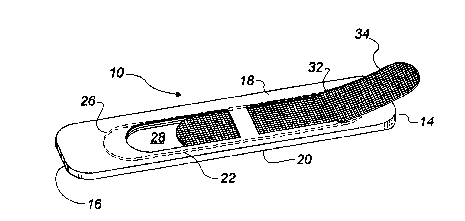Some of the information on this Web page has been provided by external sources. The Government of Canada is not responsible for the accuracy, reliability or currency of the information supplied by external sources. Users wishing to rely upon this information should consult directly with the source of the information. Content provided by external sources is not subject to official languages, privacy and accessibility requirements.
Any discrepancies in the text and image of the Claims and Abstract are due to differing posting times. Text of the Claims and Abstract are posted:
| (12) Patent: | (11) CA 2124889 |
|---|---|
| (54) English Title: | METHOD OF SECURING A FILTER ELEMENT TO A BLADE OF A FAN |
| (54) French Title: | METHODE POUR FIXER UN ELEMENT FILTRANT SUR UNE PALE DE VENTILATEUR |
| Status: | Term Expired - Post Grant Beyond Limit |
| (51) International Patent Classification (IPC): |
|
|---|---|
| (72) Inventors : |
|
| (73) Owners : |
|
| (71) Applicants : | |
| (74) Agent: | NATHAN V. WOODRUFFWOODRUFF, NATHAN V. |
| (74) Associate agent: | |
| (45) Issued: | 1998-07-28 |
| (22) Filed Date: | 1994-06-01 |
| (41) Open to Public Inspection: | 1994-12-16 |
| Examination requested: | 1994-10-11 |
| Availability of licence: | N/A |
| Dedicated to the Public: | N/A |
| (25) Language of filing: | English |
| Patent Cooperation Treaty (PCT): | No |
|---|
| (30) Application Priority Data: | ||||||
|---|---|---|---|---|---|---|
|
There is described a method of securing a filter element
to a blade of a fan. Firstly, form a cavity within a fan
blade. The cavity has a tip end oriented toward a tip of the
fan blade and a root end oriented toward a root of the fan
blade. Secondly, form at least one flow passage extending from
one broad surface of a fan blade through the cavity to an
opposed broad surface of the fan blade, such that air
circulates through the cavity via the flow passages upon
movement of the fan blade. Thirdly, form an access opening
through which a filter element is inserted into the cavity.
Méthode pour fixer un élément filtrant à une pale de ventilateur. La méthode comporte les étapes suivantes : pratiquer une cavité à l'intérieur de la pale, l'extrémité de la cavité étant orientée vers l'extrémité de la pale et une base orientée vers la base de la pale; réaliser au moins un passage d'écoulement partant d'une surface large de la pale en passant par la cavité pour se rendre jusqu'à la face large opposée de la pale de manière que l'air circule dans la cavité par les passages d'écoulement lorsque la pale bouge; réaliser un orifice d'accès par lequel un élément filtrant est inséré dans la cavité.
Note: Claims are shown in the official language in which they were submitted.
Note: Descriptions are shown in the official language in which they were submitted.

2024-08-01:As part of the Next Generation Patents (NGP) transition, the Canadian Patents Database (CPD) now contains a more detailed Event History, which replicates the Event Log of our new back-office solution.
Please note that "Inactive:" events refers to events no longer in use in our new back-office solution.
For a clearer understanding of the status of the application/patent presented on this page, the site Disclaimer , as well as the definitions for Patent , Event History , Maintenance Fee and Payment History should be consulted.
| Description | Date |
|---|---|
| Inactive: Expired (new Act pat) | 2014-06-01 |
| Inactive: Office letter | 2011-05-03 |
| Revocation of Agent Requirements Determined Compliant | 2011-05-03 |
| Appointment of Agent Requirements Determined Compliant | 2011-05-03 |
| Inactive: Office letter | 2011-04-28 |
| Small Entity Declaration Request Received | 2008-04-29 |
| Small Entity Declaration Determined Compliant | 2008-04-29 |
| Inactive: IPC from MCD | 2006-03-11 |
| Inactive: Late MF processed | 1999-07-09 |
| Letter Sent | 1999-06-01 |
| Grant by Issuance | 1998-07-28 |
| Inactive: IPC removed | 1998-05-22 |
| Inactive: First IPC assigned | 1998-05-22 |
| Inactive: Final fee received | 1998-03-19 |
| Pre-grant | 1998-03-19 |
| Notice of Allowance is Issued | 1997-09-23 |
| Letter Sent | 1997-09-23 |
| Notice of Allowance is Issued | 1997-09-23 |
| Inactive: Status info is complete as of Log entry date | 1997-09-15 |
| Inactive: Application prosecuted on TS as of Log entry date | 1997-09-15 |
| Inactive: IPC assigned | 1997-08-11 |
| Inactive: IPC removed | 1997-08-11 |
| Inactive: IPC assigned | 1997-08-11 |
| Inactive: IPC removed | 1997-08-11 |
| Inactive: IPC assigned | 1997-08-11 |
| Inactive: IPC removed | 1997-08-11 |
| Inactive: IPC assigned | 1997-08-11 |
| Inactive: IPC removed | 1997-08-11 |
| Inactive: IPC assigned | 1997-08-11 |
| Inactive: IPC removed | 1997-08-11 |
| Inactive: IPC assigned | 1997-08-11 |
| Inactive: IPC removed | 1997-08-11 |
| Inactive: First IPC assigned | 1997-08-11 |
| Inactive: Approved for allowance (AFA) | 1997-08-07 |
| Application Published (Open to Public Inspection) | 1994-12-16 |
| Request for Examination Requirements Determined Compliant | 1994-10-11 |
| All Requirements for Examination Determined Compliant | 1994-10-11 |
There is no abandonment history.
The last payment was received on
Note : If the full payment has not been received on or before the date indicated, a further fee may be required which may be one of the following
Please refer to the CIPO Patent Fees web page to see all current fee amounts.
Note: Records showing the ownership history in alphabetical order.
| Current Owners on Record |
|---|
| WILLIAM KURYLIW |
| Past Owners on Record |
|---|
| None |